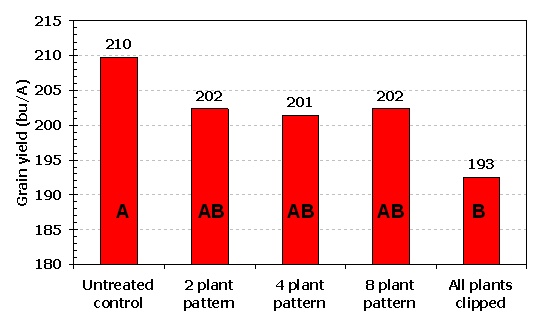Frost Impact on Corn at Early Growth Stages
May 18, 2007
Joe Lauer, Corn Agronomist
Over the last couple of mornings (May 17 and 18) a light frost hit much of Wisconsin.
Farmers are reporting frost damage to corn and other crops over widespread areas
in northern Wisconsin and scattered low spots further south. Most corn growth stages
are between just planted to V2-V3 (Ritchie et al., 1993). Farmers and agronomists
usually do not worry about frost at these early stages of development. Early frost
can have an impact on grain yield, but the trade-off between planting date impact
on yield is greater than for frost damage impact on yield. Delayed planting further
impacts profitability due to greater moisture and consequential drying costs.
Experiments were conducted in 2001, 2002, 2003, 2004, and 2005 to measure the impact
of early defoliation on corn grain yield. Clipping treatments were applied at V2,
V4 and V6. Clipping treatments consisted of cutting the plant at ground level with
a scissors. Plants in the control treatment were not clipped. In another treatment,
all plants in the plot were clipped. In another set of treatments, half of the plants
were clipped in 2-, 4-, and 8-plant patterns. For example in the 2-plant pattern,
the first 2 plants in the row were not clipped, the next 2 plants were clipped at
ground level, the next 2 plants were not clipped, and so on.
Although these treatments do not fully simulate the light frost damage that recently
occurred on corn over the last couple of evenings, they do provide some guidance
on what a hard frost might do that completely defoliates the plant without killing
it. Figure 1 describes the impact of complete defoliation on corn grain yield at
the V2 stage of development. When all plants were clipped, grain yield decreased
17 bu/A from 210 to 193 bu/A (8%). When half of the plants were clipped in various
patterns, grain yield was not affected; the trend was a decrease of 8 to 9 bu/A
(4%).
These data indicate that frost early in development has relatively little impact
on corn grain yield. If all of the leaves are removed from every plant in the field
at the V2 stage of development and plants are not killed, then the expectation is
that grain yield would decrease up to 8%. If the recent frosts were hard enough
to kill plants then use the publication
UWEX 3353 for guidance on whether or not to keep a stand and what to look
for when assessing plant health.

Figure 1. Impact of clipping corn leaves at V2. Experiments were conducted in 2001,
2002, 2003, 2004, and 2005 at Arlington, WI. Treatments consisted of clipping at
ground level (or not clipping) consecutive plants in 2-, 4-, 8-, and all-plant patterns.
Further Reading
Carter, P.R. 1995.
Late-Spring Frost and Postfrost Clipping Effects on Corn Growth and Yield.
Journal of Production Agriculture 8:203-209.
Lauer, J.G. 1997. Corn
replant / late-plant decisions in Wisconsin. University of Wisconsin Extension.
Bulletin A3353.
Ritchie, W.<, J. J. Hanway, and G. O. Benson. 1993.
How a corn plant develops. Iowa State University CES 21.